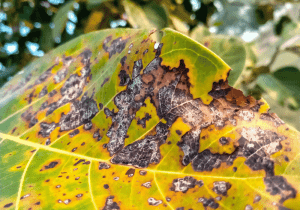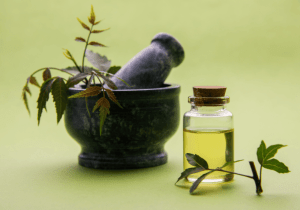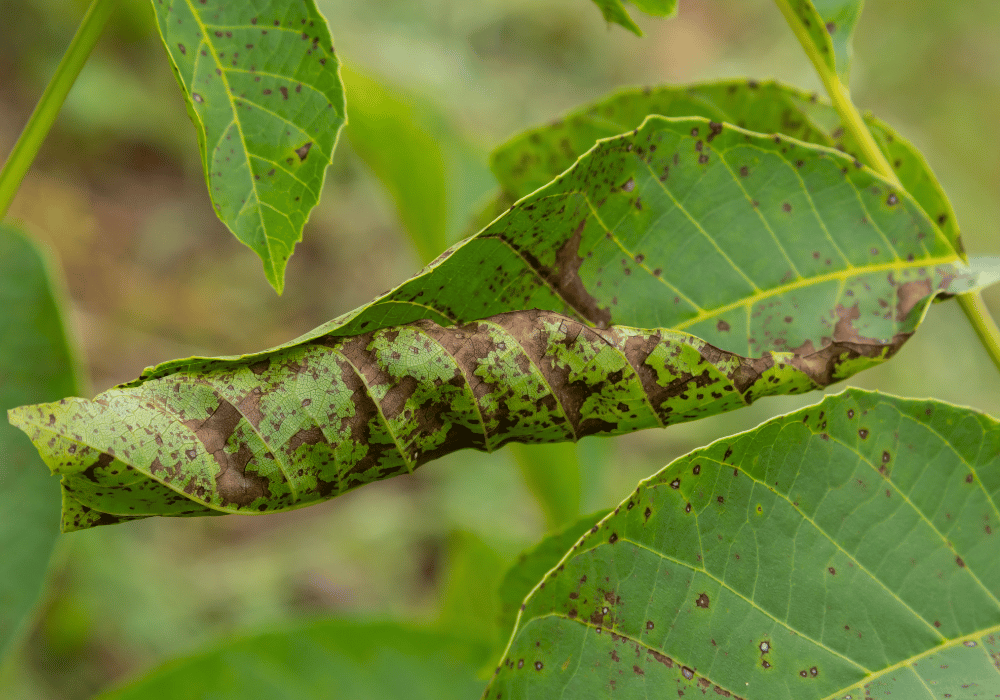Healthy trees are more than just a beautiful addition to your yard; they provide shade, improve air quality, and boost your landscape’s aesthetic appeal. But the summer season can be challenging for trees as high temperatures, humidity, and the stress of the growing season create a perfect environment for diseases to thrive. From weakening the tree’s structure to affecting its ability to grow, summer tree diseases can have long-lasting impacts if left untreated. The purpose of this blog is to help you identify and treat some of the most common summer tree diseases. Through proper identification and management, you can ensure your trees remain healthy and resilient, even in the face of environmental challenges.
Common Summer Tree Diseases
Anthracnose
 Anthracnose is one of the most common fungal diseases to affect trees in the summer. It typically targets hardwood trees such as sycamores, oaks, maples, and dogwoods. The symptoms include irregular, dark lesions on leaves, stems, or even twigs. Over time, the leaves may curl, become distorted, or fall prematurely. A moist and humid climate provides the ideal conditions for Anthracnose to spread, particularly after extended periods of rainy weather.
Anthracnose is one of the most common fungal diseases to affect trees in the summer. It typically targets hardwood trees such as sycamores, oaks, maples, and dogwoods. The symptoms include irregular, dark lesions on leaves, stems, or even twigs. Over time, the leaves may curl, become distorted, or fall prematurely. A moist and humid climate provides the ideal conditions for Anthracnose to spread, particularly after extended periods of rainy weather.
Environmental stress often exacerbates Anthracnose infections, weakening your tree’s ability to fend off the disease. If left unchecked, this fungal attack can cause significant defoliation and stunt the tree’s overall growth. Proper identification of Anthracnose is critical, as its symptoms may resemble those of nutrient deficiencies or drought stress. Early detection can prevent significant damage and reduce its spread.
Powdery Mildew
Powdery Mildew is another fungal disease that thrives during warm, humid summer conditions. This disease is easy to identify with its signature white or gray powdery coating on leaves, stems, and sometimes even buds. While Powdery Mildew typically doesn’t kill trees, it can weaken them and make them susceptible to other stressors, such as pests or extreme weather.
Susceptible tree species include apples, crabapples, dogwoods, and magnolias. Leaves affected by Powdery Mildew often show signs of curling, discoloration, or early leaf drop. Shaded areas with poor air circulation are particularly prone to its spread. Additionally, the rapid growth of new foliage is more vulnerable to infection. Recognizing this disease early can prevent its escalation and preserve your tree’s aesthetic and health.
Apple Scab
Apple Scab is a fungal disease primarily affecting apples, crabapples, and pear trees. Symptoms typically appear as olive-green to black spots on leaves, which later turn yellow and fall prematurely. The fruit may also develop blemishes, rendering it unappealing and sometimes inedible.
This disease is particularly widespread during wet summers, as prolonged moisture on leaves offers ideal conditions for fungal spores to germinate. Over time, repeated annual infections can weaken trees, reduce their fruit yields, and make them more vulnerable to other diseases or environmental stressors. Close monitoring is essential to catch Apple Scab early, as it spreads rapidly once it takes hold.
Identifying Tree Diseases
Visual inspection is the first step in identifying tree diseases. Regularly checking your trees’ foliage, bark, and overall structure can help catch irregularities early. Look for signs such as discolored or wilted leaves, unusual growth patterns, or lesions on foliage or bark. These visual cues can indicate the onset of a disease before it has a chance to spread further.
Differentiating between diseases often comes down to closely examining the symptoms. For example, while Anthracnose produces irregular dark spots, Powdery Mildew creates a distinct powdery coating. Similarly, Apple Scab’s green or black spots and accompanying leaf drop make it unique. When in doubt, professional diagnosis can provide clarity.
Certified arborists and plant pathologists use advanced diagnostic tools to confirm the specific disease affecting your tree. Lab tests can analyze fungal spores or bacterial infections to deliver a precise diagnosis. By taking this route, you avoid misidentifying the problem and applying ineffective treatments.
Treatment and Prevention
 Cultural practices can significantly reduce the risk of tree diseases. Proper watering is essential, as overwatering promotes fungal growth while underwatering weakens the tree’s defenses. Mulching around the base of the tree helps regulate moisture levels and prevents soil-borne pathogens from splashing onto the trunk or leaves. Regular pruning fosters better air circulation and removes diseased or dead branches that could propagate infections.
Cultural practices can significantly reduce the risk of tree diseases. Proper watering is essential, as overwatering promotes fungal growth while underwatering weakens the tree’s defenses. Mulching around the base of the tree helps regulate moisture levels and prevents soil-borne pathogens from splashing onto the trunk or leaves. Regular pruning fosters better air circulation and removes diseased or dead branches that could propagate infections.
Organic treatments are a safer alternative for environmentally conscious homeowners. Neem oil is a widely used natural fungicide that works against Powdery Mildew and other fungal diseases. Compost tea, rich in beneficial microbes, can also enhance a tree’s resistance to infections. When applying these treatments, consistency is key. Most organic remedies require repeated applications to remain effective.
For severe cases, chemical treatments such as fungicides may be necessary. Fungicides containing ingredients like copper or sulfur are effective in controlling many summer tree diseases. Always follow application guidelines carefully and wear protective gear to ensure safe handling. While chemical treatments can be highly effective, they should be used as a last resort or under the recommendation of a professional arborist to avoid unintended environmental impacts.
When to Call a Professional
There are times when tree diseases become too complex to manage alone. If you notice widespread infection, severe defoliation, or structural instability, it’s time to call a professional. Certified arborists have the expertise and tools to accurately diagnose and treat advanced cases of tree diseases, potentially saving the tree from irreversible damage.
Consulting a professional also provides the added benefit of long-term monitoring and care. They can recommend season-specific maintenance practices to prevent future outbreaks and detect early signs of disease before they become problematic. Tree care specialists can also ensure that chemical treatments are applied correctly, minimizing potential harm to the surrounding environment.
When seeking professional help, choose a tree care service with proper certifications and positive customer reviews. Reputable services like 855TREEMAN can provide customized solutions to address your specific tree care needs while offering peace of mind.
Proactive tree care is essential during the summer months. By recognizing the signs of common diseases like Anthracnose, Powdery Mildew, and Apple Scab, and implementing effective treatment strategies, you can safeguard the health and longevity of your trees. Whether it’s through regular visual inspections, using organic remedies, or consulting a professional, your efforts make all the difference in preventing and managing summer tree diseases.
At 855TREEMAN, we’re committed to helping you maintain beautiful, healthy trees all year round. Contact us today for expert advice and services tailored to your tree care needs.


